
Pinus strobus, commonly called the eastern white pine, northern white pine, white pine, Weymouth pine (British), and soft pine is a large pine native to eastern North America. It occurs from Newfoundland, Canada, west through the Great Lakes region to southeastern Manitoba and Minnesota, United States, and south along the Appalachian Mountains and upper Piedmont to northernmost Georgia and perhaps very rarely in some of the higher elevations in northeastern Alabama. It is considered rare in Indiana.
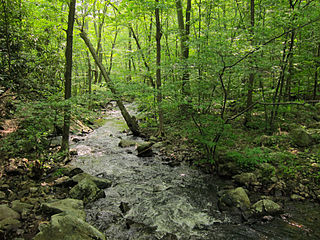
The Northeastern coastal forests are a temperate broadleaf and mixed forests ecoregion of the northeast and middle Atlantic region of the United States. The ecoregion covers an area of 34,630 sq miles (89,691 km2) encompassing the Piedmont and coastal plain of seven states, extending from coastal southwestern Maine, southeastern New Hampshire, eastern Massachusetts, and Rhode Island, southward through Connecticut, New York State, New Jersey, southeast Pennsylvania, Delaware and Maryland.

Heritage Documentation Programs (HDP) is a division of the U.S. National Park Service (NPS) responsible for administering the Historic American Buildings Survey (HABS), Historic American Engineering Record (HAER), and Historic American Landscapes Survey (HALS). These programs were established to document historic places in the United States. Records consist of measured drawings, archival photographs, and written reports, and are archived in the Prints and Photographs Division of the Library of Congress.
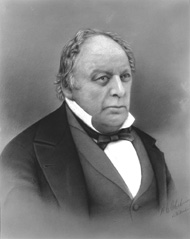
Alexander Parris was a prominent American architect-engineer. Beginning as a housewright, he evolved into an architect whose work transitioned from Federal style architecture to the later Greek Revival. Parris taught Ammi B. Young, and was among the group of architects influential in founding what would become the American Institute of Architects. He is also responsible for the designs of many lighthouses along the coastal Northeastern United States.

The Great Rose Bowl Hoax was a prank at the 1961 Rose Bowl, an annual American college football bowl game. That year, the Washington Huskies were pitted against the Minnesota Golden Gophers. At halftime, the Huskies led 17–0, and their cheerleaders took the field to lead the spectators in the stands in a card stunt, a routine involving flip-cards depicting various images for the audience to raise. However, a number of students from the California Institute of Technology managed to alter the card stunt shown during the halftime break, by making the Washington fans inadvertently spell out CALTECH.

Little Pine State Park is a Pennsylvania state park on 2,158 acres (873 ha) in Cummings Township, Lycoming County, Pennsylvania in the United States. Little Pine State park is along 4.2 miles (6.8 km) of Little Pine Creek, a tributary of Pine Creek, in the midst of the Tiadaghton State Forest. A dam on the creek has created a lake covering 94 acres (38 ha) for fishing, boating, and swimming. The park is on Pennsylvania Route 4001, 4 miles (6.4 km) northeast of the unincorporated village of Waterville or 8 miles (13 km) southwest of the village of English Center. The nearest borough is Jersey Shore, Pennsylvania, about 15 miles (24 km) south at the mouth of Pine Creek on the West Branch Susquehanna River.
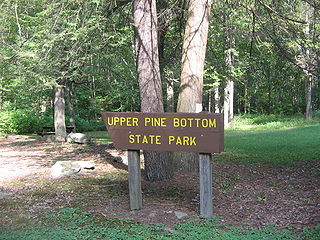
Upper Pine Bottom State Park is a 5-acre (2.0 ha) Pennsylvania state park in Lycoming County, Pennsylvania in the United States. The park is in Cummings Township on Pennsylvania Route 44 and is surrounded by the Tiadaghton State Forest. It is on Upper Pine Bottom Run, which gave the park its name and is a tributary of Pine Creek. Upper Pine Bottom State Park is in the Pine Creek Gorge, where the streams have cut through five major rock formations from the Devonian and Carboniferous periods.
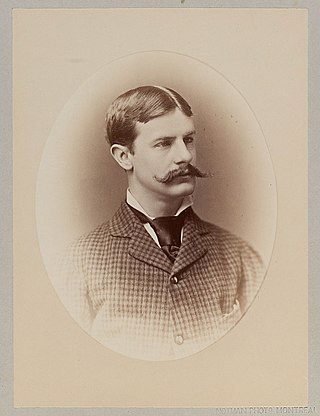
Edmund March Wheelwright was one of New England's most important architects in the late nineteenth and early twentieth centuries, and served as city architect for Boston, Massachusetts from 1891 to 1895.

Grey Towers National Historic Site, also known as Gifford Pinchot House or The Pinchot Institute, is located just off US 6 west of Milford, Pennsylvania, in Milford Township. It is the ancestral summer home of Gifford Pinchot, first chief of the newly developed United States Forest Service (USFS) and twice elected governor of Pennsylvania.
Jack Lueders-Booth is an American photographer. He retired from teaching at Harvard in 2000, and continues to live and work in the Boston area.
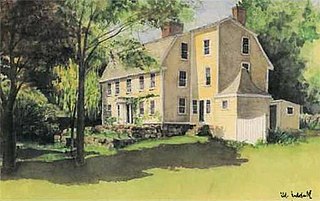
The Babson-Alling House is a historic colonial house in Gloucester, Massachusetts. The 2.5-story Georgian house was built in 1740 by William Allen, and remains one of Gloucester's finest houses of the period. It is a typical house of the time, with a center chimney plan and a gambrel roof. The house was bought by Joseph Low in 1779; his daughter Elizabeth married Nathaniel Babson, and their son ended up inheriting the property. It remained in the Babson family into the 20th century, eventually being inherited by Low descendant Elizabeth Alling.
The Nantucket forests have an unusual history. Continual salt saturated wind and nutrient poor soils set severe limits upon tree growth and the wood products that might be accessed by both indigenous peoples and colonial settlers.
Stotham is a fictional town in Massachusetts, United States which was invented by architect Hubert G. Ripley (1869-1942) of the firm Ripley and LeBoutillier in an article he wrote for the April 1920 issue of the White Pine Series of Architectural Monographs as the purported locale of a number of photographs of New England structures which had been edited out of earlier location-specific issues of the bi-monthly series.

Frederick Denkmann was an American lumber baron based in Rock Island, Illinois. He teamed up with his brother-in-law Friedrich Weyerhäuser and formed Weyerhäuser-Denkmann Lumber Company.

The history of the lumber industry in the United States spans from the precolonial period of British timber speculation, subsequent British colonization, and American development into the twenty-first century. Following the near eradication of domestic timber on the British Isles, the abundance of old-growth forests in the New World posed an attractive alternative to importing choice timber from the Baltic via the narrow straits and channels between Denmark and Sweden. The easily available timber proved an incredible resource to early settlers, with both domestic consumption and overseas trade fueling demand. The industry expanded rapidly as Americans logged their way across the country. In this pursuit, hundreds of thousands of indigenous peoples were displaced, murdered, and enslaved for the purpose of the timber industry.

Old Pine Church, also historically known as Mill Church, Nicholas Church, and Pine Church, is a mid-19th century church located near to Purgitsville, West Virginia, United States. It is among the earliest extant log churches in Hampshire County, along with Capon Chapel and Mount Bethel Church.

The Hillsborough Mills are a historic textile manufacturing complex at 37 Wilton Road in western Milford, New Hampshire, near its town line with Wilton. The oldest buildings of the brick mill complex were built in 1866 as a carpet-making operation. This business failed in 1874, but the complex was acquired by other textile interests, and eventual saw success producing carpet yarns, and blankets for horses and bedding. The mills were closed in 1970, and have since been adapted for other uses. The complex was listed on the National Register of Historic Places in 2014.

The William Peabody House is a historic house on North River Road in Milford, New Hampshire. This 2+1⁄2-story wood-frame house was built c. 1740 by William Peabody, the first English settler of the Milford area, and remains a good example of Georgian residential architecture despite a 1973 fire. The house was listed on the National Register of Historic Places in 1979.
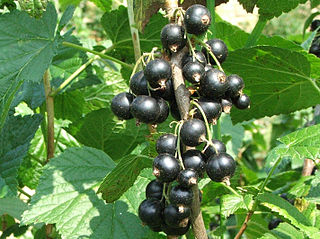
Blackcurrant production in the United States is relatively limited. The blackcurrant was introduced by English settlers at the Massachusetts Bay Colony in 1629 and was cultivated on some scale, particularly in New York. The plant acts as a host for the white pine blister rust that threatened the timber industry. In 1911, the federal government banned the cultivation, sale, and transport of blackcurrants to protect the white pine. Government programs systematically destroyed blackcurrant plants by chemical spraying.
















